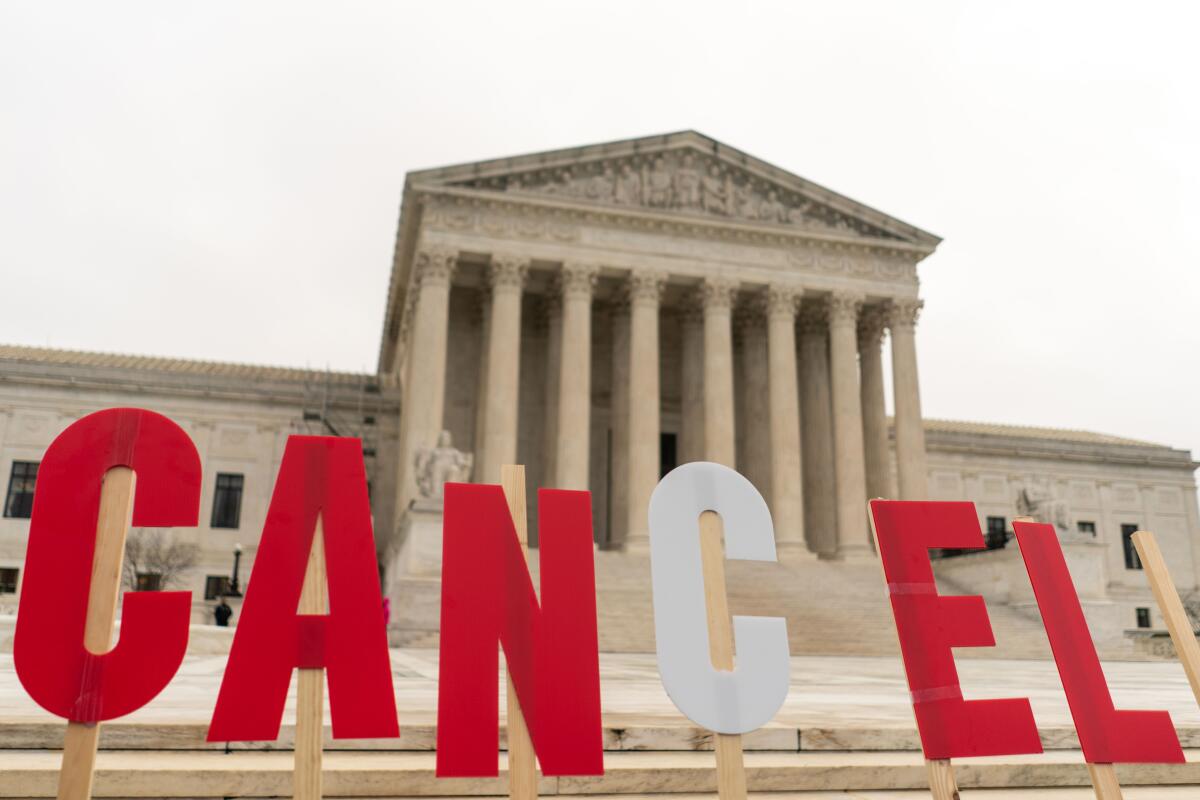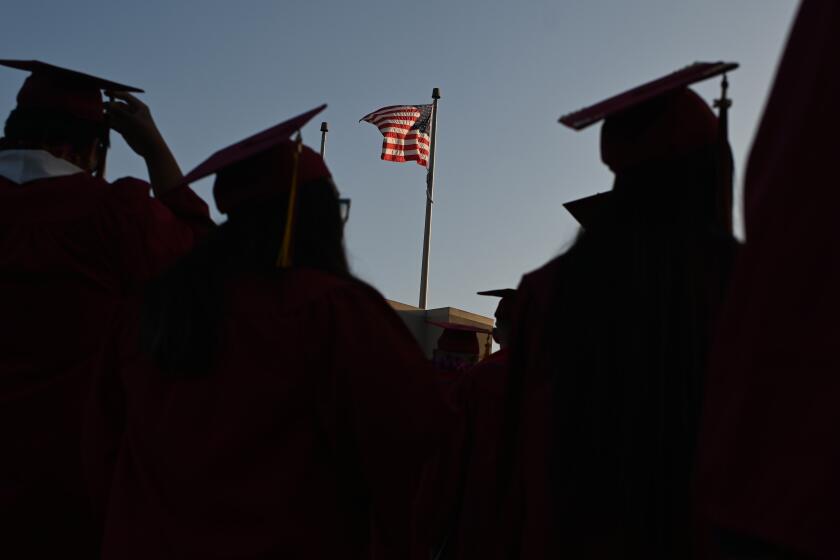Supreme Court casts more doubt on Bidenâs plan to forgive student loans

WASHINGTON â The Supreme Courtâs conservatives gave a sharply critical hearing Tuesday to President Bidenâs plan to forgive more than $400billion in student loans, arguing that only Congress can approve such a large amount of federal spending.
âWeâre talking about half a trillion dollars and 43 million Americans,â Chief Justice John G. Roberts Jr. told Solicitor Gen. Elizabeth Prelogar at the outset of Tuesdayâs argument.
âWe take very seriously the idea of the separation of powers and that power should be divided to prevent its abuse,â he said.
âYour view [is] that the president can act unilaterally, that there was no role for Congress to play in this ... and ... thereâs no role for us to play in this either.â
The chief justiceâs comments set the tone for three hours of arguments. His views were echoed by other conservative justices, who suggested Biden had overstepped his authority.
The presidentâs plan for student debt relief could still survive if the justices decide its challengers do not have legal standing to sue.
Taxpayers do not have standing to sue to stop the government from spending money, and itâs not clear whether anyone can show they will be hurt if the government forgives another personâs loan.
But the conservative justices did not sound as though they were thinking of tossing out either of the two related cases before them.
In December, the justices voted to keep in place lower court orders that blocked Bidenâs plan from taking effect. But they agreed to hear the administrationâs argument in support of the student debt relief plan.
With the high court expressing skepticism about Bidenâs debt forgiveness, student loan borrowers are on notice that relief may not materialize.
In the first of two cases heard on Tuesday, lawyers for Nebraska, Missouri and four other Republican-led states contended that the COVID-19 pandemic did not give the president the power to cancel student loans, and that Biden was seeking to fulfill a campaign promise.
Missouri argued that its higher-education agency will lose money if it has fewer student loans to process. Several other Republican-led states said they may lose tax revenue if loans are wiped out. And two Texas residents who did not qualify for relief under Bidenâs plan say they lost the procedural right to file objections with the Education Department.
In defense of the administration, the solicitor general said the pandemic had caused âenormous disruptionâ and left millions struggling to pay their bills. And Congress in the past had authorized the Education secretary to âwaive or modifyâ provisions of the federal student aid program during a national emergency.
But Roberts and Justice Clarence Thomas said the word âmodifyâ does not describe a policy to forgive loans that would amount to more than $400billion. Instead, they said, this was a major change that should be decided by Congress.
It sounded as though the courtâs conservatives would apply the same standard to student debt relief that they used in a recent climate change case.
Last year, the six conservative justices blocked a proposed climate change policy being considered by the Environmental Protection Agency.
The chief justice noted that Congress had not authorized a rule that would force the states to transform their systems of generating electricity by closing down coal-fired plants and switching to wind or solar power.
While Congress could adopt such a policy, Roberts said in that case the EPAâs regulators could not do so on their own.
At several points, Roberts and Justices Samuel A. Alito Jr., Neil M. Gorsuch and Brett M. Kavanaugh questioned the fairness of Bidenâs plan. They said other students, current and past, chose not take out loans or have paid back their debts.
The chief justice posed an example of two high school friends: one who takes out a loan for college and a second who takes out a loan to start a lawn care service. How is it fair, he asked, for the government to forgive the loan of the college graduate, but not the other?
Kavanaugh said he was troubled that the president or agency officials would create a âmassive new programâ based on an old and vaguely worded law, or a claim of national emergency.
âSome of the biggest mistakes in the courtâs history were deferring to assertions of executive emergency power,â he said. And âsome of the finest moments in the courtâs history were pushing back against presidential assertions of emergency power,â he added.
Kavanaugh was referring to a 2003 law adopted during the Iraq war that authorized the Education secretary to modify the student aid program âin connection with a war or other military operation or national emergency.â
At the time, lawmakers said they were concerned about those who were called up to serve abroad. The measure was used to waive monthly repayments for some, but it did not lead to the cancellation of loans.
Two years ago, Congress briefly considered the issue of student loan forgiveness but took no action.
Then last year, the Biden administration said it had the authority to forgive loans under the 2003 law. The aim of the law was to ensure that âaffected individuals are not placed in a worse position financially,â and the administration said student borrowers were in worse financial shape due to the pandemic.
The Trump administration suspended repayments on federal student loans shortly after the pandemic was declared, and those payments have not resumed under Biden. The solicitor general said the suspension costs the government $5billion a month.
In August, Education Secretary Miguel Cardona decided that borrowers would be in a worse position if they had to resume their monthly payments, and proposed forgiving loans of up to $10,000 for eligible borrowers with federal adjusted gross incomes below $125,000, or $250,000 for couples filing jointly.
Because those who receive Pell Grants tend to have lower incomes, they can have up to $20,000 forgiven under the plan.
But before the justices can rule on Bidenâs plan, they must decide whether anyone has legal standing to challenge it in court. Typically that means some person or entity, such as a state, must show they are or will be harmed by a law or government action.
The solicitor general contended Tuesday that none of the states had such standing. In that case, she said, the court has no authority to decide their lawsuits.
Justice Amy Coney Barrett asked several questions about the statesâ standing, but she was the only conservative on the court who sounded uncertain on that issue.
If the justices agree that Missouri has standing to sue, it appears that six of them will rule against the administration. But the debt relief plan could survive if at least two of the conservatives decide the challengers do not have standing.
The courtâs three liberals â Justices Elena Kagan, Sonia Sotomayor and Ketanji Brown Jackson â said they were skeptical that the states or the Texas plaintiffs had standing to sue.
Decisions in the two cases â Biden vs. Nebraska and Department of Education vs. Brown â will probably not be handed down until late June.
The administration says required student loan repayments will not resume until after the court has ruled.
More to Read
Get the L.A. Times Politics newsletter
Deeply reported insights into legislation, politics and policy from Sacramento, Washington and beyond. In your inbox three times per week.
You may occasionally receive promotional content from the Los Angeles Times.












